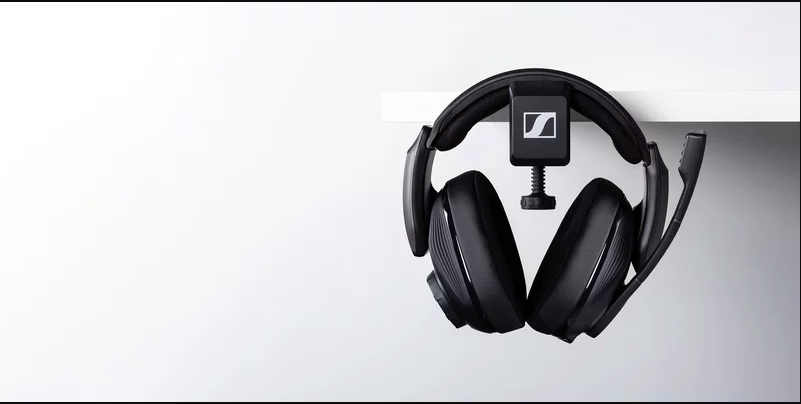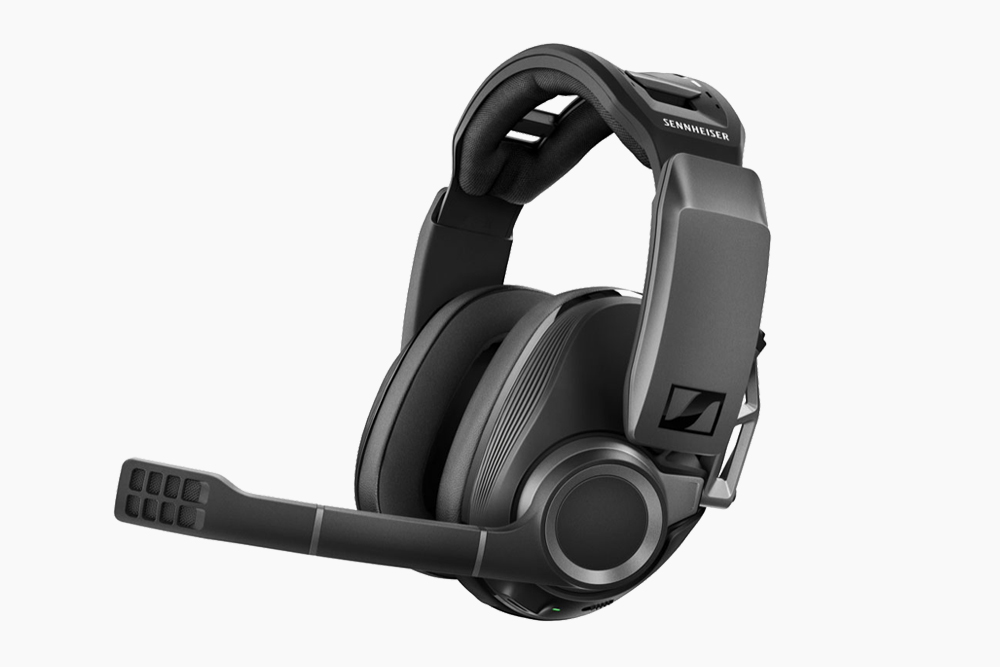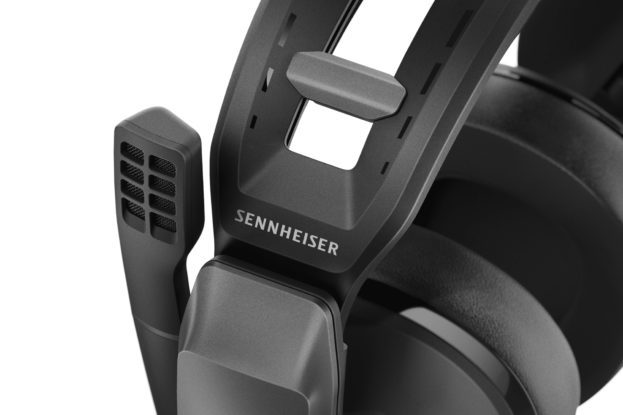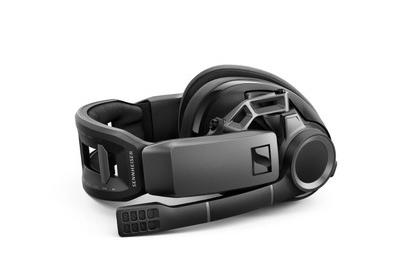Tom's Hardware Verdict
The Sennheiser GSP 670 is a truly luxurious and comprehensive wireless gaming headset that really sings, whether for music, film, or gaming.
Pros
- +
Useful control layout
- +
Good boom arm mic mute system
- +
Powerful bass
- +
Optional virtual 7.1 surround sound
Cons
- -
Very expensive
- -
Looks busy
- -
Rivals offer similarly great sound
- -
Software required to program button
Why you can trust Tom's Hardware
With the Sennheiser GSP 670, the company's first wireless gaming headset, Sennheiser lands on a real special blend of finesse and function.
Priced at $350/£299 at the time of writing, the GSP 670 shares some mechanical similarities with Sennheiser’s GSP 600 wired headset and the same speaker technology in each earcup. However, this cable-free model features a 16-hour battery life (or up to 20 when connected via Bluetooth) and very low latency. That Bluetooth compatibility means the GSP 670 can be used with just about any device you can throw at it, from PCs, to consoles, smartphones and tablets. Although not the best gaming headset around, a generous roster of controls and fundamentally impressive sound quality, combined with a great feel and weight make an argument for its premium price.
Sennheiser GSP 670 Specs
| Driver Type | Neodymium magnet |
| Impedance | 28 Ohms |
| Frequency Response | 10Hz-23KHz |
| Design Style | Closed back |
| Microphone Type | Bidirectional electret condenser |
| Connectivity | Wireless via USB, Bluetooth 5 |
| Weight | 0.9 pounds (398g) |
| Cord Length | N/A |
| Battery Life | USB dongle: 16 hoursBluetooth: 20 hours |
| Lighting | None |
| Software | Sennheiser Gaming Suite |
Design and Comfort
Visually, the GSP 670 continues the GSP family’s aesthetic, which one might unkindly describe as Terminator earmuffs. The headset's overall look is probably the aspect with which I'm least enamored. But Sennheiser was right to keep the headset's scheme muted by using black and gray and avoiding RGB lighting or accent colors. With this many angles and surfaces, you don't need any additional details.
You can customize the look of these cans by buying branded cover plates from Sennheiser's online store for $10, with Dota 2 and SK Gaming (German eSports company) variants currently available. I'm all for this growing headset market trend for customization (SteelSeries' swappable headbands and plates for its Arctis-series headsets have really kicked things off).
Fortunately for your head, the GSP 670's physical looks are the result of careful choices made in the name of comfort. At 398g, it's on the heavy side for a gaming headset, but discomfort simply isn't an issue with these cans. This is thanks to the mechanical outline of the headband and metal single-sided yoke, combined with an adjustable caliper pressure system at the top of the headband. By adjusting two sliders at each side of the headband, you can control precisely how much pressure the earcups exert on your delicate cranium, which is fantastically handy for anyone with an especially large or small head.
Sennheiser didn't skimp on construction materials here either. The memory foam and leatherette contact point covers are top-of-the-line, conveying value from the second we pulled the headset out of its box. The headband's generous padding at the top of the head did its job, keeping me comfortable, for hours. This kind of super-soft padding tends to hold its shape and resistance quite well over time too, so we expect a pretty uniform comfort experience for the first few months of wear. With the right adjustments, the earcups never dug in but felt firmly attached enough that I could move my head around comfortably without the headset shifting position.
A perennial favorite feature of mine about Sennheiser’s gaming headsets is the boom arm design. In short, it has a mic mute built in so that you're automatically muted when pushing the arm up and back to broadcasting when it's down. The satisfying click felt when doing this really tells of the construction quality. I defy you not to move it up and down aimlessly, just enjoying the sensation, when you first use the headset.
Get Tom's Hardware's best news and in-depth reviews, straight to your inbox.
A newer feature on the Senny cans is the inclusion of separate chat and game mix controls on the left earcup. I actively miss the chat mix thumb wheel of Arctis-brand headsets when we use rivals, so it's great to see similar control schemes adopted elsewhere. If the game volume swells especially loud, during cut scenes for example, you can make a quick adjustment without having to delve into any options menus or alt-tab out. Likewise, if you're getting sick of your Discord buddies hollering nonsense into your earholes while you're the only one left alive in your co-op game of choice, one twist of the chat volume sends them to oblivion. Handy.
Audio Performance
Not much is different in the audio department of the wireless GSP 670 compared to the wired GSP 600. The same neodymium magnet drivers articulate the sound, and the response is noticeably powerful at the bass end (more so than previous Sennheiser models, like the Game One, which articulated the details beautifully in both open-backed and closed-backed variants).
There's always a slight trade-off when the EQ curve is styled to sound good rather than to sound totally flat as with studio monitors. Usually, it comes in the tiny details in the upper midrange and the treble. However, the overall sound is better for its intended purpose when it's sculpted in this way.
You couldn't master an album using them, but for gaming, movies, TV and music, these cans sounded wonderful. There's a liveliness to them, which I suspect comes down to the luxuriousness of the contact points as much as the drivers. I could feel the music swelling and pulsing in pressure changes, as well as hear it. It's a sensation I've always loved in Bose's closed-back headphones and am always thrilled to find in the gaming market. Perhaps some gamers will find it a bit too busy at the bass end, but the GSP 670 really speaks to my personal preference.
This headset is virtual 7.1 surround sound compatible by using the Sennheiser Gaming Suite software's Binaural Rendering Engine. If you want to get serious and listen out for positional audio cues in the likes of CS:GO, Sennheiser's proprietary surround algorithm has your back and, indeed, your front and sides. You can make out a cold, 'digital' quality to the DTS: HeaphoneX algorithm, as it articulates a wide surround space. The same's true here, but it's definitely easier to pinpoint sound effects when it's enabled. A useful tool, rather than an additive note to the audiophile experience, then. As an added bonus, it can be turned on and off using a programmable button on the left earcup. You do need to delve into the software to set that up, though.
Features and Software
Sennheiser's software suite is a pleasant, no-nonsense affair, allowing quick and painless customization of EQ curves, mic noise-cancelling levels, the aforementioned surround sound and battery life monitoring. Personally, I very rarely use custom EQ software profiles and found the mic noise cancellation levels to be just right out-of-the-box. But the options are there if you want them. Our only minor irritation is that the software's required to program the button on the left side to perform various functions. The program didn't virtual switch surround sound on and off until I installed the program.
Battery Life
The reported battery life of 16 hours via the wireless dongle sounds like a fair estimation based on our testing; although, we haven't had our sample unit long enough to test how quickly that number degrades over time when it's had a few charges.
Bluetooth pairing to smartphones was easy. The 20-hour battery life via that connection held true at least for the first charge.
Bottom Line
The truth is, in 2019, there's very little between the best-sounding gaming headsets. The SteelSeries Arctis Pro Wireless ($290 at the time of writing) and HyperX Cloud Alpha ($100) both sound stellar, and the same's true of the wired Sennheiser GSP 600 ($249) and our review subject. These minute differences in audio characteristics make it very difficult to recommend one headset above all other purely on the basis of its sound quality. It really is all about the benefits of the whole package now.
This is the most complete and best-sounding gaming headset package Sennheiser has put together to date. It's also very expensive. The sound is fantastic, but the same is true of the cheaper, wired GSP 600 - and indeed much cheaper rivals from SteelSeries and HyperX.
The high price precludes it being a no-brainer pick. But those willing to pay extra for increased durability, replaceable parts and a real feeling of luxury will be richly rewarded for their outlay.
Image Credits: Sennheiser
MORE: All Gaming Headset Content
-
nitrium What is the difference between a "gaming headset" and a regular "headphone"? Is there any reason why you can't use, for example, Sony WH-1000MX3 or Bose QuietComfort bluetooth headphone for gaming (both have built in microphones, and without the ridiculous looking arm)? They also have FAR better battery life, are noise cancelling (a must have feature if you've ever tried it), are cheaper, and have low latency bluetooth compatibility. If you Google "best wireless headphones" you don't see many (if any) of these seemingly overpriced "gaming headsets", so I wonder where the value is.Reply -
cryoburner ReplyHowever, this cable-free model features a 16-hour battery life (or up to 20 when connected via Bluetooth) and very low latency.
Not only were the battery life claims not tested, but the "very low latency" was not tested either. It would be nice to see benchmarks for some of the characteristics of these headsets rather than just subjective opinions and the manufacturer's specifications. That likely wouldn't be too hard to do within a week of mostly unattended tests.
For battery life, after cycling the battery a couple times, play a loop of music and put a microphone in an earcup to record the output (a very low data rate would be fine), so that you can review the audio the following day to know exactly what time it cuts out. Perhaps repeat the process at a high and low volume level to determine the potential range, and using both connection methods.
You might not be able to directly compare the results against other headsets unless there were a good way to calibrate them to a specific volume level though, which might require something like a binaural microphone that simulates human ears to more accurately account for different headset designs.
And latency tests could involve playing a quick high-frequency chirp through both a wired 3.5mm headset and the test headset at the same time, and recording the results (at a high data rate), then zooming in on the waveform in something like Audacity to determine the separation between the two output devices. I get the impression latency could vary significantly from one wireless headset to the next, and between the different connection options. -
Dantte Can we get a review comparing high-end headsets? I use Audio Technica ATH-ADG1x for the last few years and still have never seen these reviewed here... I guess its all about pay to play?Reply -
cryoburner Reply
Well, they likely only test products sent to them by the manufacturer, unless perhaps its for some really in-demand item. I imagine that it wouldn't exactly be practical for them to buy and review every $300 gaming headset that comes out.Dantte said:I guess its all about pay to play?



